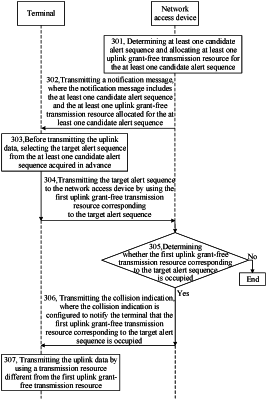| CPC H04W 72/1268 (2013.01) [H04L 5/0053 (2013.01); H04W 28/0252 (2013.01); H04W 72/23 (2023.01); H04W 74/004 (2013.01); H04W 74/0841 (2013.01)] | 16 Claims |

|
1. A method for data transmission, applied to a terminal, comprising:
receiving a notification message from a network access device; wherein the notification message comprises at least one candidate alert sequence determined by the network access device, and indication information of at least one uplink grant-free transmission resource allocated for the at least one candidate alert sequence; wherein the at least one candidate alert sequence is a group of sequences predefined by the network access device, and receiving the notification message from the network access device comprises: receiving the notification message carried in a broadcast message transmitted by the network access device, or receiving the notification message carried in an uplink grant-free transmission resource configuration message transmitted by the network access device;
selecting a target alert sequence from the at least one candidate alert sequence;
before transmitting the uplink data by using a grant-free transmission resource, transmitting the target alert sequence to the network access device by using a first uplink grant-free transmission resource corresponding to the target alert sequence; wherein the target alert sequence is configured to notify the network access device that the terminal requests to use the first uplink grant-free transmission resource to transmit uplink data; and
transmitting the uplink data by using a transmission resource different from the first uplink grant-free transmission resource, when receiving a collision indication fed back by the network access device in response to the target alert sequence.
|